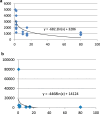Pollution of the environment and building interiors during asbestos removal as a result of lack of negative pressure in the working areas
- PMID: 39261502
- PMCID: PMC11391016
- DOI: 10.1038/s41598-024-70631-z
Pollution of the environment and building interiors during asbestos removal as a result of lack of negative pressure in the working areas
Abstract
The paper presents examples of the consequences of the lack of negative pressure in the work zone during asbestos removal. The asbestos fibre concentrations generated in those work zones were relatively low. This was due to the leakage in barriers restricting the work zone. Therefore the asbestos content in the outside air, near the renovated rooms was increasing. In the cases discussed, these works resulted in short-term pollution of the building's outdoor air to a depth of up to 15 m. Such contamination can cover the entire interior of the building. This may lead to long-term retention of asbestos fibre in the facility, despite the completion of asbestos removal. For example, non-friable asbestos-cement sheets removal in those work conditions increased indoor air by contamination up to 3000 f/m3 (outside the work zone). In the case of removing friable asbestos inside the building type "LIPSK", indoor air contamination locally was up 21,000-51,000 f/m3, and outside the work zone to 18,000-28,900 f/m3. These values are above the average concentration of asbestos fibres in the same type of buildings (< 300-400 f/m3) in regular use.
Keywords: Airborne asbestos fibre; Asbestos; Asbestos removal; Building materials; Contamination; Indoor air; Outdoor air.
© 2024. The Author(s).
Conflict of interest statement
The author declares no competing interests.
Figures




Similar articles
-
Comparison of the effects of use, protection, improper renovation and removal of asbestos products on the example of typical old office buildings in Poland.Sci Rep. 2023 Aug 21;13(1):13577. doi: 10.1038/s41598-023-37257-z. Sci Rep. 2023. PMID: 37604849 Free PMC article.
-
Measurements of airborne asbestos fibres during refurbishing.Ann Work Expo Health. 2023 Sep 21;67(8):952-964. doi: 10.1093/annweh/wxad041. Ann Work Expo Health. 2023. PMID: 37481467 Free PMC article.
-
The natural reduction of threat in selected systems of old buildings containing asbestos.Sci Rep. 2022 Feb 16;12(1):2580. doi: 10.1038/s41598-021-04487-y. Sci Rep. 2022. PMID: 35173172 Free PMC article.
-
Fungal Contamination of Building Materials and the Aerosolization of Particles and Toxins in Indoor Air and Their Associated Risks to Health: A Review.Toxins (Basel). 2023 Feb 25;15(3):175. doi: 10.3390/toxins15030175. Toxins (Basel). 2023. PMID: 36977066 Free PMC article. Review.
-
Asbestos in the air of public buildings: a public health risk?Prev Med. 1994 Jan;23(1):119-25. doi: 10.1006/pmed.1994.1017. Prev Med. 1994. PMID: 8016027 Review.
References
-
- Obmiński, A. The concentration of asbestos fibres during building exploitation analysis of concentration variability. Archiv. Civ. Mech. Eng.10.1007/s43452-021-003203-2 (2021).10.1007/s43452-021-003203-2 - DOI
LinkOut - more resources
Full Text Sources

